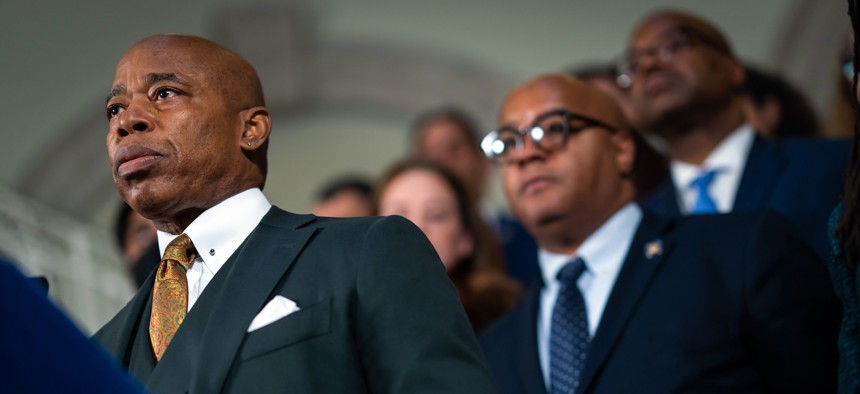Mental Health
New York City agencies to involuntarily admit more severely mentally ill persons for evaluations
Mayor Eric Adams clarified Tuesday that people do not have to be a danger to themselves or others to receive help.

New York City Mayor Eric Adams announced city agencies will be able to involuntarily transport severely mentally ill persons to care even when they are not a risk to themselves or others. Ed Reed/Mayoral Photography Office.
New York City will soon begin rolling out a sweeping effort to transport more people with severe, untreated mental illness from the streets and subways into hospitals, removing some of the red tape around involuntary hospitalization by clarifying that people who are suffering to dangerous degrees can be committed for “compassionate care” even if they aren’t posing an immediate risk to themselves or others.
The effort, announced by Mayor Eric Adams during a rare public speech from City Hall Tuesday morning, gives city agencies like the police department and other first responders new guidance that attests that legally they can – and should – bring individuals in for psychiatric evaluation and long-term treatment if they are mentally ill to the point of being unable to meet “their basic needs.” Training to ensure city employees, medical personnel and outreach workers carry out this work by treating vulnerable individuals with “compassionate care” will begin immediately, according to Adams. Kendra’s Law, legislation that allows courts to order treatment for certain people with mental illness, will also be utilized with greater frequency under the plan.
“New York law already allows us to intervene when mental illness prevents a person from meeting their basic human needs, causing them to be a danger to themselves,” Adams said, echoing a similar recent state directive. “Yet, a common misunderstanding persists that we cannot provide involuntary assistance unless the person is violent, suicidal, or presenting a risk of imminent harm. This myth must be put to rest.”
The city’s new directive comes on the heels of a string of several violent attacks that have occurred on the subway, raising some New Yorker’s concerns about public safety. Crime has increased on the sprawling transit system overall this year, and city officials have attempted to quell concerns and bolster safety by rolling out various initiatives like increased police presence. Adams said last month that people with mental health issues have largely driven that increase. On Tuesday, he struck a decidedly compassionate tone, emphasizing that the city has a “moral obligation” to help people with severe mental illness. He said the city’s “new pathway” will ensure that people who need treatment are connected with long-term care.
“The very nature of their illnesses keeps them from realizing they need intervention and support. Without that intervention, they remain lost and isolated from society, tormented by delusions and disordered thinking,” Adams said.
Homeless advocates and civil rights groups responded to the mayor’s announcement with a mingle of apprehension and wary acknowledgment of what appears to be a greater emphasis on treatment.
The Legal Aid Society and several other community-based public defender groups issued a joint statement following Adam’s announcement, claiming years of dysfunction have contributed to the city's mental health crisis.
“We are heartened to hear that Mayor Adams acknowledges that community-based treatment and least-restrictive services must guide the path to rehabilitation and recovery,” they said. “He is correct that homeless New Yorkers with mental health conditions have the right to health care, housing, treatment, respect, dignity and the hope that their futures will be safe and illnesses treated.”
Others questioned the legality of involuntary hospitalization.
“The federal and state constitutions impose strict limits on the government’s ability to detain people experiencing mental illness – limits that the mayor’s proposed expansion is likely to violate,” NYCLU Executive Director Donna Lieberman said in a statement. “Forcing people into treatment is a failed strategy for connecting people to long-term treatment and care.”
While New York City’s new directive clarifies, designates and delegates city agencies and medical teams’ responsibilities when carrying out an involuntary mental health removal, it stops short of providing extensive details about what responders should initially look for when trying to determine whether a serious mental illness is preventing them from supporting their basic needs. Broadly, the directive says, case law suggests that “serious untreated physical injury, unawareness or delusional misapprehension of surroundings, or unawareness or delusional misapprehension of physical condition or health” could be indicators.
City officials acknowledged that train stations and the street aren’t optimal conditions to complete a mental health evaluation, which is why transporting individuals to hospitals is key. There, they’ll receive an in-depth, comprehensive evaluation and referral to services based on medical professionals’ recommendations.
To help responders determine whether an individual meets the standard that would make an involuntary evaluation legal, the city is also unfurling a hotline where police would be able to speak with a mental health professional before deciding to transport them into care.
